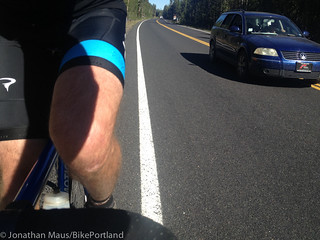Welcome to part one of a three part series on Oregon’s passing laws.
Trying to decipher Oregon’s passing laws are a perfect example of how it’s often difficult to know when (and how) a particular vehicle law applies to someone riding a bicycle. Confusion about application of the rules of the road and vehicle laws sometimes results when frustrated motor vehicle operators turn to the statutes to try to put bicycle riders in their “proper” place on the roadway; but rights and responsibilities of bicycle riders on the roadway are somewhat of a legal hybrid in the Oregon statutes. Frustration of motor vehicle operators must not be allowed to diminish the bicycle operator’s legitimate right to share the traveled portion of the roadway — and even to occupy a full lane when necessary — to avoid surface hazards or other potential dangers.
Of course, for a bicycle operator, the obligation to ride only as far to the right as practicable is the legal “bottom line,” mandated by ORS 814.430, often referred to as referred to by me as the “Oregon Bicycle Bill of Rights”, even though the statute title (“Improper Use of Lanes”) sounds like a prohibition. ORS 814.430 allows riders to maintain occupancy of the entire lane when necessary, even if motor vehicle operators have to slow until riders are able to again ride closer to the right edge.
One question posed by some drivers is whether ORS 811.425, which describes the violation of “Failure to Yield to An Overtaking Vehicle,” mandates that a person on a bike, as a “slower driver” must move their “vehicle” off the “main traveled portion of the roadway” when overtaken by a faster person in a car. ORS 811.425 states:
Failure of slower driver to yield to overtaking vehicle; penalty. (1) A person commits the offense of failure of a slower driver to yield to overtaking vehicles if the person is driving a vehicle and the person fails to move the person’s vehicle off the main traveled portion of the highway into an area sufficient for safe turnout when:
(a) The driver of the overtaken vehicle is proceeding at a speed less than a designated speed under ORS 911.105;
(b) The driver of the overtaking vehicle is proceeding at a speed in conformity with ORS 811.105;
(c) The highway is a two directional, two-lane highway; and
(d) There is no clear lane for passing available to the driver of the overtaking vehicle.
(2) This section does not apply to the driver of a vehicle in a funeral procession.
(3) The offense described in this section, failure of a slower driver to yield to overtaking vehicle, is a Class B traffic violation.
In State of Oregon v. Potter (2002), the Oregon Court of Appeals reviewed a Critical Mass rider’s conviction for impeding traffic (ORS 811.130). That law provides “a person commits the offense of impeding traffic if the person drives a motor vehicle or a combination of motor vehicles in a manner that impedes or blocks the normal and reasonable movement of traffic.” At trial, the defendant argued that the statute only applied to motor vehicles. ORS 801.360 defines a motor vehicle as “a vehicle that is self-propelled or designed for self propulsion.” Clearly, a bicycle is not a motor vehicle. “Bicycle” is defined (via ORS 801.150) as a “vehicle” that is “propelled exclusively by human power.”
However, ORS 814.400 provides:
(1) every person riding a bicycle on a public way is subject to the provisions applicable to and has the same rights and duties as the driver of any other vehicle concerning operating on highways * * *, except:
(b) when otherwise specifically provided under the vehicle code.
The court reasoned that because the text of the impeding traffic statute fails to exclude bicycles then it applies to all vehicles, including bicycles. And ORS 814.430 specifically provides in paragraph (c) that bicycles are not excused from compliance with the requirements of ORS 811.425 (the slow-moving vehicle law). While Oregon courts have not provided a definitive legal analysis of the relationship between the two laws, it is quite likely that these statutes would be interpreted to allow bicycles to stay in the travel lane, even if it means holding up overtaking vehicles so long as surface hazards prevent the riders from moving in safety off the main traveled portion of the roadway. After all, ORS 811.425 provides that a slow moving vehicle must only move into areas that are “sufficient for safe turnouts.” If the shoulder or area to the right of the fog line contains glass, gravel, rough spots, or other hazards, the rider has a right not to move out of the roadway.
And, ORS 814.430 (“Bicycle Bill of Rights”) provides other conditions justifying use of up to the entire lane:
(2) A person is not in violation of the offense under this section if the person is not operating a bicycle as close as practicable to the right curb or edge of the roadway under any of the following circumstances:
(c) When reasonably necessary to avoid hazardous conditions including, but not limited to, fixed or moving objects, parked or moving vehicles, bicycles, pedestrians, animals, surface hazards or other conditions that make continued operation along the right curb or edge unsafe or to avoid unsafe operation in a lane on the roadway that is too narrow for a bicycle and vehicle to travel safely side by side.
While future appellate cases may provide additional guidance on the relationship between the Rules of the Road, one statutory provision does not trump another — the right of people on bicycles to the road contained in ORS 814.430 provides both a safe haven on the roadway and the right to take the lane when necessary.
What is also clear is that people on bicycles must not impede traffic (ORS 811.130(1)), or fail to yield to faster overtaking vehicles (ORS 811.425) when there is an area “sufficient for a safe turnout”. But people on bicycles are not required to place themselves in a position of danger in order to yield to overtaking vehicles; instead, the riders must use good judgement in finding safe areas to move over as space and conditions allow. The narrow width of track of a bicycle allows the rider to utilize the full width of the pavement to allow overtaking vehicles to pass. Unlike a wide truck or trailer, overtaking vehicles can easily go around bicycle riders without requiring that the rider pull over and stop.
The Potter case serves as a warning for riders that unreasonably failing to yield to traffic or overtaking vehicles may trigger a traffic citation. What the Potter case does not change is the right to take the lane when reasonable necessary for safety, even if it means slowing down overtaking vehicles.

(Photo © J. Maus/BikePortland)
This article is part of our monthly legal series with Portland-based lawyer and bike law expert Ray Thomas of Swanson, Thomas, Coon & Newton. (Disclaimer: STC&N is a BikePortland advertiser and this monthly article is part of our promotional partnership.)


